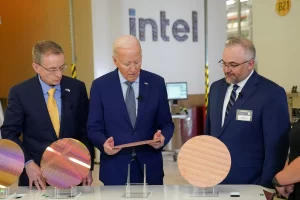U.S. Approves $7.86 Billion Grant to Boost Intel’s Chip Manufacturing

The U.S. government has officially allocated a massive $7.86 billion grant to Intel for advancing domestic semiconductor manufacturing. This decision is part of a broader effort to bolster the country’s chip-making capabilities and reduce dependency on foreign suppliers, especially amid growing competition with China. The funding, provided under the CHIPS and Science Act, underscores Washington’s strategic push to secure a leadership position in the semiconductor industry, which is vital for everything from smartphones to national security systems.
Intel’s significant investment in its new Ohio facility, often referred to as the “Silicon Heartland,” is central to this initiative. The plant, set to become one of the largest chip manufacturing hubs in the world, aims to boost the U.S. share of global semiconductor production, which has dwindled from 37% in the 1990s to about 12% today. The facility is expected to create thousands of jobs, both directly in manufacturing and indirectly through its ripple effects on the local economy.
This funding aligns with the U.S. government’s vision to enhance resilience in the tech supply chain. Recent disruptions caused by global events like the COVID-19 pandemic and geopolitical tensions highlighted the vulnerabilities of relying heavily on overseas chipmakers. By investing in Intel and other domestic companies, the U.S. hopes to mitigate risks and ensure a steady supply of semiconductors critical to economic growth and innovation.
However, challenges remain. Building and scaling semiconductor plants require significant time and resources, and the global market’s competitive nature means that the U.S. must also focus on innovation to stay ahead. Additionally, while the CHIPS Act has allocated substantial funding, analysts suggest that private sector collaboration and sustained government support will be essential to fully realize these ambitious goals.
Intel’s award is not just a financial commitment; it reflects a broader national strategy to reclaim technological dominance. As the semiconductor industry continues to evolve, this investment marks a pivotal step in ensuring that the U.S. remains at the forefront of this critical sector. The success of such initiatives could define the country’s economic and technological trajectory for decades to come.



